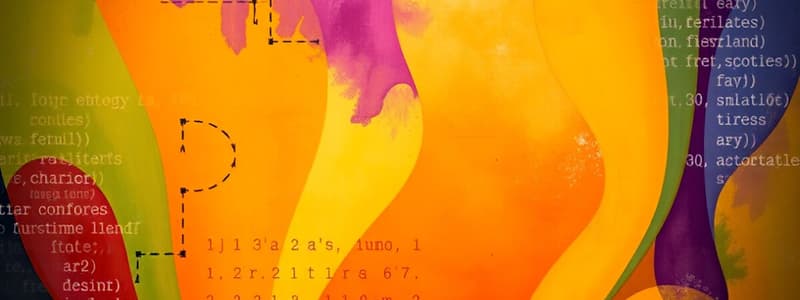Podcast
Questions and Answers
Which Java data type is used to represent an employee's age?
Which Java data type is used to represent an employee's age?
- int (correct)
- boolean
- double
- String
What method is used to display the current date in Java?
What method is used to display the current date in Java?
- LocalDate.now() (correct)
- LocalDate.display()
- LocalDate.current()
- LocalDate.getCurrentDate()
What method is used to retrieve the numeric representation of the month in a LocalDate object?
What method is used to retrieve the numeric representation of the month in a LocalDate object?
- getMonth()
- getMonthValue() (correct)
- getDayOfMonth()
- getYear()
Which of the following methods can be used to check if a file is writable?
Which of the following methods can be used to check if a file is writable?
Which class is used to represent both date and time in Java?
Which class is used to represent both date and time in Java?
What is the purpose of the DateTimeFormatter class in Java?
What is the purpose of the DateTimeFormatter class in Java?
When formatting a date as 'Month Day', which pattern would you use with DateTimeFormatter?
When formatting a date as 'Month Day', which pattern would you use with DateTimeFormatter?
What is the return type of the delete() method in the File class?
What is the return type of the delete() method in the File class?
Which of the following is false about the boolean data type in employee details?
Which of the following is false about the boolean data type in employee details?
Which method will provide the absolute pathname of a file?
Which method will provide the absolute pathname of a file?
What class would you import to obtain only the current time in Java?
What class would you import to obtain only the current time in Java?
To create a new directory in Java, which method would you use?
To create a new directory in Java, which method would you use?
What does the 'T' in the date-time representation signify?
What does the 'T' in the date-time representation signify?
In the employee details structure, which data type is used to store the salary?
In the employee details structure, which data type is used to store the salary?
What will the createNewFile() method return if the file already exists?
What will the createNewFile() method return if the file already exists?
Which method can be used to retrieve the number of bytes in a file?
Which method can be used to retrieve the number of bytes in a file?
What is the correct syntax to create an enum in Java?
What is the correct syntax to create an enum in Java?
Which of the following statements about enum values is true?
Which of the following statements about enum values is true?
How can you access an enum constant in Java?
How can you access an enum constant in Java?
In which scenario are enums often utilized in Java?
In which scenario are enums often utilized in Java?
What will be printed when the code 'System.out.println(myVar);' is executed with myVar set to Level.MEDIUM?
What will be printed when the code 'System.out.println(myVar);' is executed with myVar set to Level.MEDIUM?
What is the correct syntax to create a Scanner object?
What is the correct syntax to create a Scanner object?
Which method is used to read Strings from input?
Which method is used to read Strings from input?
What does the values() method return when called on an enum type?
What does the values() method return when called on an enum type?
Which of the following is NOT a characteristic of enums?
Which of the following is NOT a characteristic of enums?
Which method is used to read integers from input?
Which method is used to read integers from input?
What will happen if you enter an incorrect input type when using nextInt()?
What will happen if you enter an incorrect input type when using nextInt()?
What happens if two enum constants share the same name?
What happens if two enum constants share the same name?
In the Employee Management System, which data type is used for employee salary?
In the Employee Management System, which data type is used for employee salary?
In the example provided, how do you read a continuous string input?
In the example provided, how do you read a continuous string input?
What type of input does the last prompt in the Employee Management System ask for?
What type of input does the last prompt in the Employee Management System ask for?
What will be the output after entering 'John Doe', 30, 55000.75 for name, age, and salary respectively?
What will be the output after entering 'John Doe', 30, 55000.75 for name, age, and salary respectively?
What is returned by the method when a file is successfully created?
What is returned by the method when a file is successfully created?
What must be managed with a try...catch block during file operations?
What must be managed with a try...catch block during file operations?
Which class is used to create a new file in the provided Java code?
Which class is used to create a new file in the provided Java code?
What will happen if the createNewFile() method is called on an existing file?
What will happen if the createNewFile() method is called on an existing file?
How should file paths be specified on Windows systems?
How should file paths be specified on Windows systems?
What method from the FileWriter class is used to write text to the file?
What method from the FileWriter class is used to write text to the file?
What is the purpose of e.printStackTrace() within the catch block?
What is the purpose of e.printStackTrace() within the catch block?
What will the absolute path print if a file is successfully created?
What will the absolute path print if a file is successfully created?
What does the method myObj.canRead() return?
What does the method myObj.canRead() return?
Which of the following classes is NOT mentioned for file operations in Java?
Which of the following classes is NOT mentioned for file operations in Java?
What is printed when a file does not exist when using the File class?
What is printed when a file does not exist when using the File class?
Which method is used to delete a file in Java?
Which method is used to delete a file in Java?
What will be the output if a user tries to delete a file that is currently open?
What will be the output if a user tries to delete a file that is currently open?
What type of information does myObj.length() provide?
What type of information does myObj.length() provide?
What will be the output if a user attempts to access a file that does not exist using the File class?
What will be the output if a user attempts to access a file that does not exist using the File class?
Which method is used to retrieve the name of the file represented by a File object?
Which method is used to retrieve the name of the file represented by a File object?
What does the method myObj.canWrite() return if a file is writable?
What does the method myObj.canWrite() return if a file is writable?
What will the delete() method return if a file is successfully deleted?
What will the delete() method return if a file is successfully deleted?
Which of the following classes can be used to write data to files in Java?
Which of the following classes can be used to write data to files in Java?
What does myObj.length() provide when called on a File object?
What does myObj.length() provide when called on a File object?
Which condition must be met for the exists() method to return true for a File object?
Which condition must be met for the exists() method to return true for a File object?
What will happen if the delete() method is called on a folder that contains files?
What will happen if the delete() method is called on a folder that contains files?
Flashcards
Scanner object creation
Scanner object creation
Creates an object to read input from the console.
Import statement for Scanner
Import statement for Scanner
Imports the Scanner class from the Java util package
Reading strings from input
Reading strings from input
The nextLine() method reads a whole line of text as a string.
Reading integers from input
Reading integers from input
Signup and view all the flashcards
InputMismatchException
InputMismatchException
Signup and view all the flashcards
Input int data type
Input int data type
Signup and view all the flashcards
Input double data type
Input double data type
Signup and view all the flashcards
Input boolean data type
Input boolean data type
Signup and view all the flashcards
Enum
Enum
Signup and view all the flashcards
Enum Creation
Enum Creation
Signup and view all the flashcards
Enum Access
Enum Access
Signup and view all the flashcards
Enum in a Class
Enum in a Class
Signup and view all the flashcards
Enum in Switch
Enum in Switch
Signup and view all the flashcards
Enum values() method
Enum values() method
Signup and view all the flashcards
Enum Purpose
Enum Purpose
Signup and view all the flashcards
Enum Convention
Enum Convention
Signup and view all the flashcards
Java LocalDate
Java LocalDate
Signup and view all the flashcards
Java LocalTime
Java LocalTime
Signup and view all the flashcards
Java LocalDateTime
Java LocalDateTime
Signup and view all the flashcards
LocalDate.now()
LocalDate.now()
Signup and view all the flashcards
LocalTime.now()
LocalTime.now()
Signup and view all the flashcards
LocalDateTime.now()
LocalDateTime.now()
Signup and view all the flashcards
DateTimeFormatter
DateTimeFormatter
Signup and view all the flashcards
Date-Time API Package
Date-Time API Package
Signup and view all the flashcards
LocalDate
LocalDate
Signup and view all the flashcards
getMonth()
getMonth()
Signup and view all the flashcards
getMonthValue()
getMonthValue()
Signup and view all the flashcards
getDayOfMonth()
getDayOfMonth()
Signup and view all the flashcards
File (java.io)
File (java.io)
Signup and view all the flashcards
createNewFile()
createNewFile()
Signup and view all the flashcards
delete()
delete()
Signup and view all the flashcards
Creating a file
Creating a file
Signup and view all the flashcards
IOException
IOException
Signup and view all the flashcards
File.createNewFile()
File.createNewFile()
Signup and view all the flashcards
try...catch block
try...catch block
Signup and view all the flashcards
File object
File object
Signup and view all the flashcards
Absolute path
Absolute path
Signup and view all the flashcards
Error Handling (IOException)
Error Handling (IOException)
Signup and view all the flashcards
Escaping backslashes
Escaping backslashes
Signup and view all the flashcards
File information
File information
Signup and view all the flashcards
File existence check
File existence check
Signup and view all the flashcards
File name retrieval
File name retrieval
Signup and view all the flashcards
File path retrieval
File path retrieval
Signup and view all the flashcards
File readability
File readability
Signup and view all the flashcards
File deletability
File deletability
Signup and view all the flashcards
File deletion
File deletion
Signup and view all the flashcards
File size
File size
Signup and view all the flashcards
Study Notes
Enums
- Enums are special classes representing a group of constants (unchangeable variables).
- Use the
enumkeyword instead ofclassorinterface. - Separate constants with commas.
- Constants should be in uppercase.
Accessing Enum Constants
- Access enum constants using a "dot" syntax.
- Example:
Level myVar = Level.MEDIUM;
Enums Inside a Class
- Enums can be defined within a class.
- The output of an enum inside a class depends on the code used to access it.
Enums in Switch Statements
- Enums are commonly used in
switchstatements to check for corresponding values. - Example:
switch (myVar)
Looping Through an Enum
- Use the
values()method to loop through enum constants. - Example:
for (Level myVar : Level.values()) { ... }
Difference Between Enums and Classes
- Enums can have attributes and methods, like classes.
- Enum constants are
public,static, andfinal(unchangeable and cannot be overridden). - Enums cannot be used to create objects or extend other classes, but can implement interfaces.
Java User Input (Scanner)
- The
Scannerclass is used to get user input. - To use, create a
Scannerobject:Scanner myObj = new Scanner(System.in); - Use methods like
nextLine(),nextInt(),nextDouble(),nextBoolean()to read different data types.
Input Types (Scanner)
nextBoolean(): Reads a boolean value.nextByte(): Reads a byte value.nextDouble(): Reads a double value.nextFloat(): Reads a float value.nextInt(): Reads an integer value.nextLine(): Reads a string value.nextLong(): Reads a long value.nextShort(): Reads a short value.
Integer Input from the User
- The
nextInt()method is used to take integer input from the user.
Java Dates and Times
- Java uses the
java.timepackage for date and time handling. LocalDate: Represents a date (year, month, day).LocalTime: Represents a time (hour, minute, second, nanoseconds).LocalDateTime: Represents both date and time.DateTimeFormatter: Formats date and time objects.
Formatting Date and Time
- Use
DateTimeFormatter.ofPattern()to format dates and times in a specific way.
File Handling
- Java's
java.iopackage provides classes for file handling (e.g., creating, reading, updating, deleting). - The
Fileclass represents a file or directory path, allows file and directory interactions. - The
createNewFile()method attempts to create a new file. - The
delete()method deletes a file or directory.
Actions on Files
- Methods like
canRead(),canWrite(),exists(),getName(),getAbsolutePath(),length(),list(),mkdir()are used for various file and folder interactions. - The
FileWriterclass writes content to a file. - The
FileReaderclass and theScannerclass read content from a file.
Studying That Suits You
Use AI to generate personalized quizzes and flashcards to suit your learning preferences.




